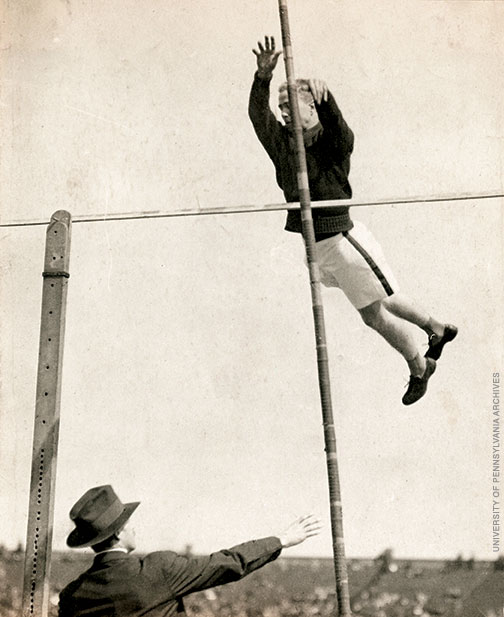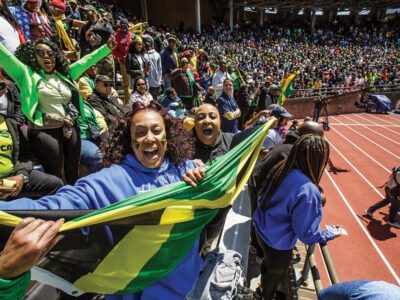
After nearly 50 years of love for the Penn Relays, finding a way onto the field.
By Larry Spector | A soft mist hung in the chilly air above Franklin Field. Standing in the track infield, on a wet patch of green artificial turf, I readied myself to take the first step onto the narrow orange surface of the pole vault runway. The bar was set at 15 feet—a nearly unimaginable height for me. But I looked up ahead, fixed my eyes on the bar, and prepared to spring into action…
I first learned about the Penn Relays as a teenager in the 1960s, reading the Philadelphia Inquirer’s celebrated sports section. The morning after a race—long before Instagram brought real-time color pictures into the palm of your hand—the paper would seem almost to burst with black-and-white shots of runners straining every neck, arm, and leg muscle, with agony on their faces as they crossed exhausted over the finish line. Ron Delaney, Frank Budd, Larry James, Paul Drayton, Marty Liquori: these were world-class athletes, usually pictured a stride or two ahead of top track competitors from around the country. For me they marked the beginning of a timeline that continued with Carl Lewis, Leroy Burrell, Jon Drummond, Marion Jones, Alyson Felix, Michael Johnson, and Usain Bolt.
They also became part of a family tradition. My dad ran in the Penn Relays as a grade-school kid in the early 1930s. My youngest daughter ran as a 14-year-old in 2000. I was never a track star, yet for all but perhaps five of the 45 years since I graduated Penn, I’ve taken my seat: 16 rows up in the East stands, directly opposite the high jump pit, with a view of the curve at the top of the stretch toward the finish line of the track.
I would go with my two daughters, first as kids, later as Penn students stealing away from scholarly pursuits for a few hours on Championship Saturday, and now with their spouses and college friends. (My wife is a longtime no-show. “What’s the point? It’s the same thing every year, just people running around and around.”) Every year would find us surrounded by the most diverse crowd you’ll see at any sporting event. Black and white, male and female, young and old. Kids cheering for their high school siblings, parents rooting for sons and daughters, older classmates reuniting year after year in the same seats. No alcohol, no hooligans, no Eagles fan anarchy.
The Relays are the oldest and finest track and field competition in the United States. Penn has hosted the event annually since 1895, and the old fashioned red-and-blue horizontal stripes of the Quakers’ track uniforms hearken back to that time. Some 110,000 spectators fill the stands—more than attend any other track-and-field meet except the Olympics and the World Championships. More athletes—men and women in equal numbers—compete over its three days than at any other such meet in the world. Twelve thousand athletes! They represent high-school teams, college teams, and their countries. From teenage relay runners to Olympic athletes in training, all make the late-April pilgrimage to Franklin Field a rite of spring.
They come to partake of pure sport. Cross the line first, jump the highest, throw the farthest, you win. There are no time outs and no bitching at referees. No disputed scoring plays or fouls. But for an hour of televised Saturday races billed “USA Against The World,” there are no TV timeouts. You won’t see winners at the end of a race clowning like wide receivers doing dance routines for cameras in the end zone, or foul shooters reaching out for hand slaps every time they score one point. Instead you’ll take in runners gasping for breath and hugging each other at the finish line, and losers embracing winners. You will see an exhausted winning team jogging an extra lap draped in the flag of its country or school, all smiles, waving up to section after section of applauding fans.
No athletic event better displays the human spirit. Runners a lap behind the leader gut it out with just as much determination. And fans cheer for the last finisher as much as for the first. World-class athletes give it their all on the same oval where physically challenged kids run Special Olympics races. Men 75 years and older—sometimes as old as 90—chug down the track in the Masters 100 meter dash. The crowd goes wild.
Recent years have seen the proliferation of thousands of green, black, and yellow flags waving in the stands whenever a Jamaican team is on the track. Chants for St. Jago, Vere Tech, Wolmer: “JA-MAI-CA, JA-MAI-CA.” And always the resounding response for Long Beach Poly, Camden, Brooklyn Boys, or other American competition: “U-S-A! U-S-A!” A few years ago a Jamaican daughter-in-law joined my family. So now we are a house divided, and the trash talk is no holds barred.
I was proud of my own trash talk in 2010—exuberantly proclaiming the imminent defeat of Usain Bolt as he readied himself for the anchor leg in the 4 by 100-meter relay, with his Jamaican team trailing their American rivals. At least 300 people must have heard my exultant cries. In the row below, two young women wearing Jamaican-flag head scarves turned around, smiled, and laughed at me. I continued screaming until Bolt took the baton. He started out three yards behind the American anchor runner—and accelerated like a rocket car in a drag race. He passed the American, and, with his running start, finished his 100 meters in a breathtaking 8.9 seconds. The crowd roared in awe. One of the women in front me took off her Jamaican flag head scarf and tied it around my head. A guy from the next section over crossed the aisle with a big Jamaican flag on a pole and stuck it in my hands. So there I was forced to eat crow, waving the Jamaican flag with its colors wrapped around my head. Loved it.
And so I resolved a year later to leave my lifetime seats to make my debut on the field. Which is how I found myself enrolled in a three-day course to become certified as a US Track Association Official. There I was in the outfield, retrieving discuses and shot puts and taking the brunt of hazing by veteran officials who insisted that catching a thrown javelin in mid-air was a rite of passage. It was that same afternoon that I experienced (with apologies to my wife) the most exciting two-tenths of a second of my entire life.
I was helping the pole-vault officiating crew, next to the backstretch of the track. The crowd had fallen to a hush, waiting for the start of the USA versus the World 4 by 100 meter relay. The gun sounded. Ten seconds later I was looking down the track as the second fastest man in the world, Justin Gatlin, roared toward me with baton in hand. He had to pass it to his teammate, Doc Patton, within the 20-yard passing zone right in front of me.
Gatlin entered the zone at top speed as Patt0n rose out of a crouch 10 yards ahead of him. Accelerating, Patt0n looked straight ahead, churning his legs with one arm extended behind him ready to receive the baton. Just inside the end of the 20-yard zone, Patt0n had reached top speed, Gatlin had caught up to him reaching forward with the baton, and in a split-second flow of musculature and speed they connected as Gatlin dipped the baton into Patton’s outstretched hand. Wow, what a pass. Ecstasy in motion: the very meaning of in stride. The USA won going away.
But I still had my own job to do.
So how did I perform with the bar set at 15 feet? Well, I took one big step sideways off the wet artificial turf, slipped on the runway, did a split, and heard my hamstring—actually heard it—pop inside of my leg. But I wasn’t trying to clear the bar. I was trying to catch the pole. I was a pole catcher—positioned to catch or pick up the pole that each vaulter shoved back toward the runway as he pushed off over the bar. And that I did, pain be damned, and kept at it until the final vaulter had planted his last pole. The doctor could wait. After all, I had a whole year to recuperate until my next meet.
Larry Spector C’71 has served on the field in each of the last three Penn Relays, mostly recently as a track marshal.




